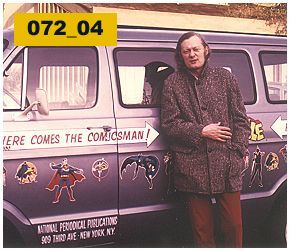cataroo.com
Home of John Cawley
Dedicated to My Wife & Times - A Site for Sore Eyes
Back To Archives
Back To Main Page
|
Frames of Time... 072_04 - Bruce Hamilton In a world of collectors and dreamers, Bruce stood out as a man of action. His involvement in comic fandom helped transform the hobby into big business. I was fortunate enough to be around for a few of these events. When I first met Bruce, he was a late night disc jockey in Phoenix. We met at conventions and corresponded on occasion. His experience in entertainment gave him more insight than many comic dealers at the time. At the time, most collectors, like myself, contented themselves with picking up old issues and reading and studying them. Most "dealers" simply sold comics at the rare convention and in an occasional ad. Bruce saw the hobby as being something bigger than a weekend business. Back in the 1970s, a local collector and associate was the proud owner of a copy of Action Comics #1. Though his wife wanted to liquidate the valuable issue, the collector kept her at bay by stating he would only sell it for $1000. By way of conversation, I mentioned this to Bruce. At that time, the highest prices paid for a comic ranged around $500. However, Bruce was a visionary collector. He knew that in his years of collecting he had only seen one or two copies. To complete his collection he decided he would have to bite the bullet and get the comic. In order to keep the collector from backing down on his offer, I waited until we were at his home and chatting with his wife. I asked if he was still waiting for $1000 to sell the Action. He grinned and said yes. I then pulled out the $1000, in $100 dollar bills. His jaw dropped as his wife smiled wider than I had ever seen. Feeling I had "tricked" him, I agreed to let him keep the issue long enough to photograph it for his records. Oddly, when Bruce got the issue, he was disappointed in the condition. However, with the news that he had paid $1000 for a copy, he soon found himself in possession of almost a half dozen copies of the issue as collectors rushed to sell this "easy mark" a copy. Bruce sold his extra copies at a profit. One copy even went to "the prince of comic collectors". Bruce's interest in Disney and my access to Disney posters put us into another deal. He purchased a large number of Disney cartoon posters from me. At that time, they were going for around $15-25. He felt they were worth more. We discussed the only way someone would think they had more value, was if someone offered more. Taking the same tact that had worked on Action #1, Bruce put ads out offering to pay $50 for any Disney posters he did not have. Since he had such a huge collection through me, he only found a few to purchase. However, a few months later, almost any Disney cartoon short poster was selling for over $50. On a cross country trip, we discussed ways to run conventions. One idea was to get more rare guests. When he finally put on his first Phoenix con, he had Carl Barks as a guest. His friendship with Barks eventually led to his starting up the Barks lithographs. His success at selling these prints at nearly $500 convinced Disney to let Bruce start publishing a high priced Barks reprint series. Eventually, Disney discovered they could market high quality collectibles directly to the collectibles market and a new industry was born. (A sideline to this found Bruce getting the comics' rights for Disney in the U.S. which was the birth of Gladstone.) Bruce was a key player in the animation and comic art business. He worked with DC comics on ideas for distribution, including the "Comicsmobile" (pictured above with Bruce). He brokered art from comics' giant Western Publisher. He cataloged the Disney Studio art archives (where he found as many amazing finds, as disappointing losses). His businesses became more exclusive. Soon, I was once again mainly seeing him at conventions. If a history of comic fandom is ever written, no doubt many of Bruce's contributions will be included. What won't be found is what a great guy he is. My favorite Bruce tale? His sense of humor as evidenced in his hiding of materials. If work done around his various homes included opening a section of wall or floor, he would slip a bagged comic or other collectible into the space. He loved to speculate about decades later when the structure would be demolished or renovated. "Just imagine what someone will think, or wonder, when they find a bagged comic book inside a wall or under a floor."
Back To Archives Back To Main Page |
 Bruce Hamilton is one of the more amazing, entrepreneurial and brilliant individuals I ever met in the world of fandom. Despite getting off on the wrong foot by bouncing a check meant to purchase a large lot of comics in the early 1970s, we became true comrades.
Together we discussed the potential for the hobby. While we shared ideas, he took action.
Bruce Hamilton is one of the more amazing, entrepreneurial and brilliant individuals I ever met in the world of fandom. Despite getting off on the wrong foot by bouncing a check meant to purchase a large lot of comics in the early 1970s, we became true comrades.
Together we discussed the potential for the hobby. While we shared ideas, he took action.